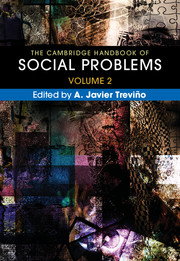Book contents
- The Cambridge Handbook of Social Problems
- The Cambridge Handbook of Social Problems
- Copyright page
- Contents
- About the Contributors
- Introduction
- Part I Problems Related to Health, Safety, and Security
- Chapter 1 Illness and Health Care
- Chapter 2 Mental Illness and Social Problems
- Chapter 3 Substance Abuse
- Chapter 4 Epidemics, Pandemics, and Outbreaks
- Chapter 5 Disaster as Social Problem and Social Construct
- Chapter 6 Surveillance
- Chapter 7 Domestic Spying: A Historical-Comparative Perspective
- Chapter 8 Computer Hacking as a Social Problem
- Chapter 9 War and Militarism
- Chapter 10 The Social Problem of Terrorism
- Chapter 11 Genocide
- Part II Problems Related to Crime and Violence
- Part III Problems of Global Impact
- Index
- References
Chapter 3 - Substance Abuse
from Part I - Problems Related to Health, Safety, and Security
Published online by Cambridge University Press: 16 March 2018
- The Cambridge Handbook of Social Problems
- The Cambridge Handbook of Social Problems
- Copyright page
- Contents
- About the Contributors
- Introduction
- Part I Problems Related to Health, Safety, and Security
- Chapter 1 Illness and Health Care
- Chapter 2 Mental Illness and Social Problems
- Chapter 3 Substance Abuse
- Chapter 4 Epidemics, Pandemics, and Outbreaks
- Chapter 5 Disaster as Social Problem and Social Construct
- Chapter 6 Surveillance
- Chapter 7 Domestic Spying: A Historical-Comparative Perspective
- Chapter 8 Computer Hacking as a Social Problem
- Chapter 9 War and Militarism
- Chapter 10 The Social Problem of Terrorism
- Chapter 11 Genocide
- Part II Problems Related to Crime and Violence
- Part III Problems of Global Impact
- Index
- References
Summary
Psychoactive substances have been used throughout human history in virtually all cultures; the United Nations Office on Drugs and Crime estimated that (globally) in 2013, approximately one out of twenty people between the ages of fifteen and sixty-four used an illicit drug. In addition, there is relatively widespread use of prescription and over-the-counter psychotherapeutic drugs. In discussing drugs as a social problem, it is important to distinguish between substance use and substance abuse, as the latter term has often been loosely applied to describe all forms of consumption of substances. In this chapter, we distinguish between physical and psychological dependence on drugs and discuss five broad categories of drugs (stimulants, depressants, hallucinogenics, marijuana, and antidepressants). We then address a variety of theories of drug use/abuse and discuss responses to substance use, noting that in the United States, criminalization has been the dominant approach. The chapter also discusses drug use prevention and treatment programs and drug courts as a response to substance use/abuse.
- Type
- Chapter
- Information
- The Cambridge Handbook of Social Problems , pp. 43 - 58Publisher: Cambridge University PressPrint publication year: 2018



